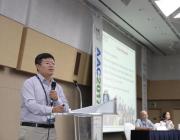摘要:
Atmospheric new particle formation (NPF) is an important phenomenon in terms of global particle number concentrations. Here we investigated the frequency of NPF, formation rates of 10 nm particles, and growth rates in the size range of 10-25 nm using at least 1 year of aerosol number size-distribution observations at 36 different locations around the world. The majority of these measurement sites are in the Northern Hemisphere. We found that the NPF frequency has a strong seasonal variability. At the measurement sites analyzed in this study, NPF occurs most frequently in March-May (on about 30 % of the days) and least frequently in December-February (about 10 % of the days). The median formation rate of 10 nm particles varies by about 3 orders of magnitude (0.01-10 cm(-3) s(-1)) and the growth rate by about an order of magnitude (1-10 nm h(-1)). The smallest values of both formation and growth rates were observed at polar sites and the largest ones in urban environments or anthropogenically influenced rural sites. The correlation between the NPF event frequency and the particle formation and growth rate was at best moderate among the different measurement sites, as well as among the sites belonging to a certain environmental regime. For a better understanding of atmospheric NPF and its regional importance, we would need more observational data from different urban areas in practically all parts of the world, from additional remote and rural locations in North America, Asia, and most of the Southern Hemisphere (especially Australia), from polar areas, and from at least a few locations over the oceans.附注:
ISI Document Delivery No.: GW7UMTimes Cited: 0Cited Reference Count: 102Nieminen, Tuomo Kerminen, Veli-Matti Petaja, Tuukka Aalto, Pasi P. Arshinov, Mikhail Asmi, Eija Baltensperger, Urs Beddows, David C. S. Beukes, Johan Paul Collins, Don Ding, Aijun Harrison, Roy M. Henzing, Bas Hooda, Rakesh Hu, Min Horrak, Urmas Kivekas, Niku Komsaare, Kaupo Krejci, Radovan Kristensson, Adam Laakso, Lauri Laaksonen, Ari Leaitch, W. Richard Lihavainen, Heikki Mihalopoulos, Nikolaos Nemeth, Zoltan Nie, Wei O'Dowd, Colin Salma, Imre Sellegri, Karine Svenningsson, Birgitta Swietlicki, Erik Tunved, Peter Ulevicius, Vidmantas Vakkari, Ville Vana, Marko Wiedensohler, Alfred Wu, Zhijun Virtanen, Annele Kulmala, MarkkuPetaja, Tuukka/A-8009-2008; Ding, Aijun/D-1610-2009Petaja, Tuukka/0000-0002-1881-9044; Ding, Aijun/0000-0003-4481-5386; Nieminen, Tuomo/0000-0002-2713-715X; Beukes, Johan Paul/0000-0003-3780-4929Academy of Finland Centres of Excellence program [272041, 1118615, 307331]; ACTRIS-2 under the European Union [654109]; EU-SAAR [R113-CT-2006-026140]; EUCAARI [0136 833-2]; MeteoSwiss; Swedish Research Council (Vetenskapradet); Swedish Environmental Protection Agency (Naturvardsverket); Swedish International Development Cooperation Agency (SIDA); German Federal Ministry for the Environment (BMU) [FE 370343200, FE 371143232]; Academy of Finland [132640, 264242, 268004, 284536]; North-West University; Vilho, Yrjo and Kalle Vaisala Foundation; Department of Earth Sciences RAS; Ministry of Foreign Affairs of Finland; TEKES Finland; DBT India [2634/31/2015]; UK Department for Environment, Food and Rural Affairs; Estonian Ministry of Education and Research [IUT20-11, IUT20-52]This work was supported by the Academy of Finland Centres of Excellence program (project numbers 272041, 1118615, 307331), ACTRIS-2 under the European Union research infrastructure action in the frame of the H2020 program for "Integrating and opening existing national and regional research infrastructures of European interest" (grant agreement 654109), EU-SAAR (R113-CT-2006-026140), and EUCAARI (0136 833-2). MeteoSwiss is acknowledged for their long-term financial support since 1995 within the Swiss component of the Global Atmosphere Watch program of the World Meteorological Organization to the operations at the Jungfraujoch site. The research at the Zeppelin, Pico Espejo, and Aspvreten stations has been carried out with the help of funding from the Swedish Research Council (Vetenskapradet), Swedish Environmental Protection Agency (Naturvardsverket), and Swedish International Development Cooperation Agency (SIDA). The measurements at the Vavihill station are part of the Swedish MERGE strategic research area. Continuous aerosol measurements at the Melpitz site were supported by the German Federal Ministry for the Environment (BMU) grants F&E 370343200 ("Erfassung der Zahl feiner und ultrafeiner Partikel in der Aussenluft") and F&E 371143232 ("Trendanalysen gesundheitsgefahrdender Fein- und Ultrafeinstaubfraktionen unter Nutzung der im German Ultrafine Aerosol Network (GUAN) ermittelten Immissionsdaten durch Fortfuhrung und Interpretation der Messreihen"). For the Tiksi and Pallas sites, we acknowledge the funding from the Academy of Finland projects "Greenhouse gas, aerosol and albedo variations in the changing Arctic"(project number 269095) and "Novel Assessment of Black Carbon in the Eurasian Arctic: From Historical Concentrations and Sources to Future Climate Impacts" (NABCEA, project number 296302), and the funding from the European Union's Horizon 2020 programs under grant agreement no. 727890 (INTAROS). Environment and Climate Change Canada is acknowledged for operating the Alert and Egbert sites. For the Budapest site, the financial support by the National Research, Development and Innovation Office, Hungary (contracts K116788 and PD124283), is acknowledged. The measurements at the Botsalano, Welgegund, and Marikana sites received funding from Academy of Finland projects "Air pollution in Southern Africa" (project number 117505) and "Atmospheric monitoring capacity building in Southern Africa" (project number 132640), from North-West University, and from the Vilho, Yrjo and Kalle Vaisala Foundation. Measurements at Tomsk were carried out under support of the Department of Earth Sciences RAS. Measurements at Mukteshwar were performed with financial support by the Ministry of Foreign Affairs of Finland, Academy of Finland (264242, 268004, 284536), TEKES Finland, and DBT India (2634/31/2015). The Harwell measurement station was supported by the UK Department for Environment, Food and Rural Affairs. Institutional research funding IUT20-11 and IUT20-52 of the Estonian Ministry of Education and Research is acknowledged for the Jarvselja site.8Copernicus gesellschaft mbhGottingen1680-7324